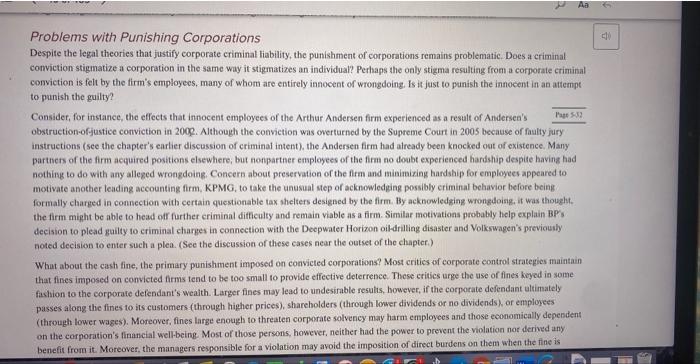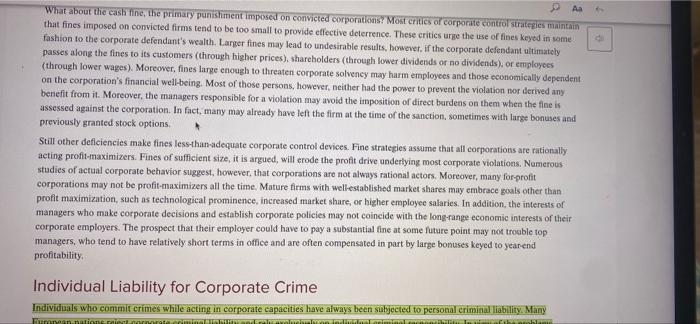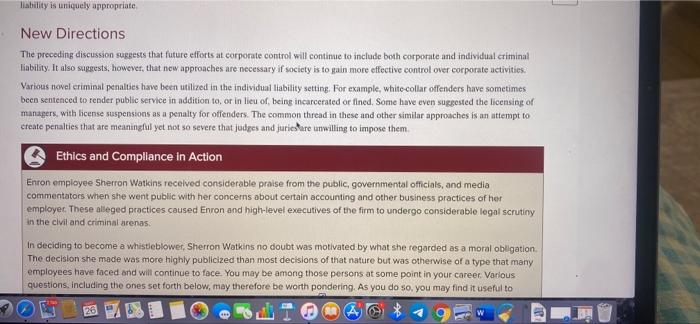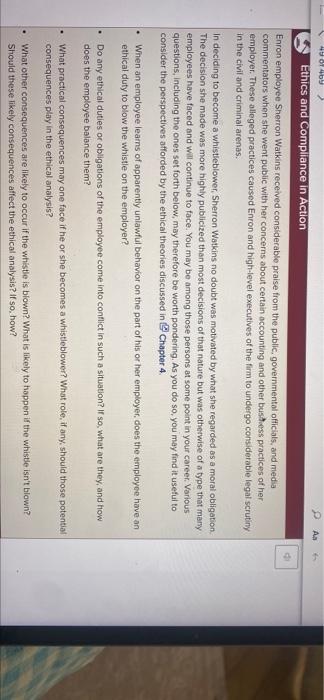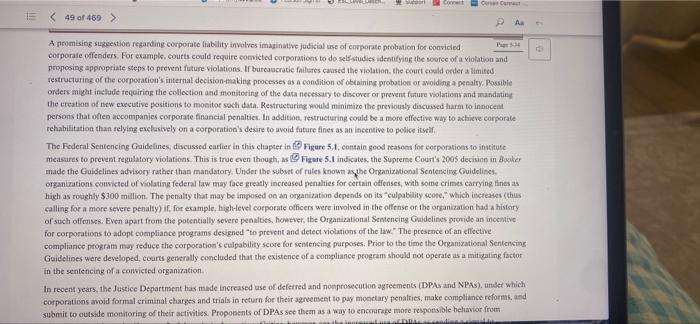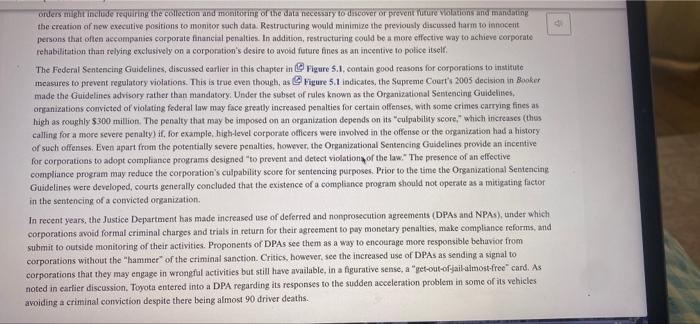- Are there any problems or challenges with punishing corporations? Identify and discuss at least one problem.
- Review the information under "new directions" (page 5-33) about new approaches for gaining more "effective control over corporate activities". Discuss one of the approaches and whether you think that it may be a viable potential suggestion.
THE ANSWER IS IN THE TEXT BELOW, HELP ME PLEASE
Aa 10 Problems with Punishing Corporations Despite the legal theories that justify corporate criminal liability, the punishment of corporations remains problematic. Does a criminal conviction stigmatize a corporation in the same way it stigmatizes an individual? Perhaps the only stigma resulting from a corporate criminal conviction is felt by the firm's employees, many of whom are entirely innocent of wrongdoing. Is it just to punish the innocent in an attempt to punish the guilty? Consider, for instance, the effects that innocent employees of the Arthur Andersen firm experienced as a result of Andersen's Pus obstruction-of-justice conviction in 2009. Although the conviction was overturned by the Supreme Court in 2005 because of faulty jury instructions (see the chapter's earlier discussion of criminal intent), the Andersen firm had already been knocked out of existence. Many partners of the firm acquired positions elsewhere, but nonpartner employees of the firm no doubt experienced hardship despite having had nothing to do with any alleged wrongdoing. Concern about preservation of the firm and minimizing hardship for employees appeared to motivate another leading accounting firm, KPMG, to take the unusual step of acknowledging possibly criminal behavior before being formally charged in connection with certain questionable tax shelters designed by the firm By acknowledging wrongdoing, it was thought the firm might be able to head off further criminal difficulty and remain viable as afirm. Similar motivations probably help explain BPS decision to plead guilty to criminal charges in connection with the Deepwater Horizon oil drilling disaster and Volkswagen's previously noted decision to enter such a plea. (See the discussion of these cases near the outset of the chapter.) What about the cash fine, the primary punishment imposed on convicted corporations? Most critics of corporate control strategies maintain that fines imposed on convicted firms tend to be too small to provide effective deterrence. These critics urge the use of fines keyed in some fashion to the corporate defendant's wealth. Larger fines may lead to undesirable results, however, if the corporate defendant ultimately passes along the fines to its customers through higher prices), shareholders (through lower dividends or no dividends) or employees (through lower wages). Moreover, fines large enough to threaten corporate solvency may harm employees and those economically dependent on the corporation's financial well-being. Most of those persons, however, neither had the power to prevent the violation nor derived any benefit from it. Moreover, the managers responsible for a violation may avoid the imposition of direct burdens on them when the fine is What about the cash fine, the primary punishment imposed on convicted corporations? Most critics of corporate control strategies maintain that fines imposed on convicted firms tend to be too small to provide effective deterrence. These crities urge the use of fines keyed in some fashion to the corporate defendant's wealth. Larger fines may lead to undesirable results, however, if the corporate defendant ultimately passes along the fines to its customers through higher prices), shareholders (through lower dividends or no dividends), or employees (through lower wages). Moreover, fines large enough to threaten corporate solvency may harm employees and those economically dependent on the corporation's financial well-being. Most of those persons, however, neither had the power to prevent the violation nor derived any benefit from it. Moreover, the managers responsible for a violation may avoid the imposition of direct burdens on them when the fine is assessed against the corporation. In fact, many may already have left the firm at the time of the sanction, sometimes with large bonuses and previously granted stock options Still other deficiencies make fines less than adequate corporate control devices. Fine strategies assume that all corporations are rationally acting profit-maximizers. Fines of sufficient size, it is argued, will erode the profit drive underlying most corporate violations. Numerous studies of actual corporate behavior suggest, however, that corporations are not always rational actors. Moreover, many for-profit corporations may not be profit maximizers all the time. Mature firms with well-established market shares may embrace poals other than profit maximization, such as technological prominence, increased market share, or higher employee salaries. In addition, the interests of managers who make corporate decisions and establish corporate policies may not coincide with the long-range economic interests of their corporate employers. The prospect that their employer could have to pay a substantial fine at some future point may not trouble top managers, who tend to have relatively short terms in office and are often compensated in part by large bonuses keyed to yearend profitability Individual Liability for Corporate Crime Individuals who commit crimes while acting in corporate capacities have always been subjected to personal criminal liability. Many Fernational Indianmol liability is uniquely appropriate New Directions The preceding discussion suggests that future efforts at corporate control will continue to include both corporate and individual criminal liability. It also suggests, however, that new approaches are necessary if society is to gain more effective control over corporate activities. Various novel criminal penalties have been utilized in the individual liability setting. For example, white collar offenders have sometimes been sentenced to render public service in addition to or in lieu of, being incarcerated or fined, Some have even suggested the licensing of managers, with license suspensions as a penalty for offenders. The common thread in these and other similar approaches is an attempt to eteate penalties that are meaningful yet not so severe that judges and juries are unwilling to impose them Ethics and Compliance in Action Enron employee Sherron Watkins received considerable praise from the public, governmental officials, and media commentators when she went public with her concerns about certain accounting and other business practices of her employer. These alleged practices caused Enron and high-level executives of the firm to undergo considerable legal scrutiny in the civil and criminal arenas. In deciding to become a whistleblower, Sherron Watkins no doubt was motivated by what she regarded as a moral obligation The decision she made was more highly publicized than most decisions of that nature but was otherwise of a type that many employees have faced and will continue to face. You may be among those persons at some point in your career. Varlous questions, including the ones set forth below, may therefore be worth pondering. As you do so, you may find it useful to 49 01 469 Aa A Ethics and Compliance in Action Enron employee Sherron Watkins received considerable praise from the public, governmental officials, and media commentators when she went public with her concerns about certain accounting and other busbess practices of her employer. These alleged practices caused Enron and high-level executives of the firm to undergo considerable legal scrutiny in the civil and criminal arenas. In deciding to become a whistleblower, Sherron Watkins no doubt was motivated by what she regarded as a moral obligation The decision she made was more highly publicized than most decisions of that nature but was otherwise of a type that many employees have faced and will continue to face. You may be among those persons at some point in your career. Various questions, including the ones set forth below, may therefore be worth pondering. As you do so, you may find it useful to consider the perspectives afforded by the ethical theories discussed in Chapter 4 When an employee learns of apparently unlawful behavior on the part of his or her employer, does the employee have an ethical duty to blow the whistle on the employer? Do any ethical duties or obligations of the employee come into conflict in such a situation? If so, what are they, and how does the employee balonce them? What practical consequences may one face if he or she becomes a whistleblower? What role, if any, should those potential consequences play in the ethical analysis? What other consequences are likely to occur if the whistle is blown? What is likely to happen if the whistle isn't blown? Should these likely consequences affect the ethical analysis? If so, how? w CCC 49 of 469 > PA A promising sugestion regarding corporate liability involves imaginative judicial use of corporate probation for convicted Page 4 corporate offenders. For example, courts could require convicted corporations to do self-studies identifying the source of a violation and proposing appropriate steps to prevent future violations. If bureaucratie failures caused the violation, the court could order a limited restructuring of the corporation's internal decision-making processes as a condition of obtaining probation or solding a penalty. Possible orders might include requiring the collection and monitoring of the data necessary to discover or prevent future violations and mandating the creation of new executive positions to monitor such data Restructuring would minimize the previously discussed harm to innocent persons that often accompanies corporate financial penalties. In addition, restructuring could be more effective way to achieve corporate rehabilitation than relying exclusively on a corporation's desire to avoid future fines as an incentive to police itself The Federal Sentencing Guidelines, discussed earlier in this chapter in Figure 5.1. contain good reasons for corporations to intitute measures to prevent regulatory violations. This is true even though, as Figure 5.1 indicates the Supreme Court's 2005 decision in Bocker made the Guidelines advisory rather than mandatory Under the subset of rules known as the Organizational Sentencing Guidelines organizations convicted of violating federal law may face greatly increased penalties for certain offenses, with some crimes carrying times as high as roughly $300 million. The penalty that may be imposed on an organization depends on its culpability score, which increases (thus calling for a more severe penalty) if, for example, high-level corporate officers were involved in the offense or the organization had a history of such offenses. Even apart from the potentially severe penalties, however, the Organizational Sentencing Guidelines provide an incentive for corporations to adopt compliance programs designed to prevent and detect violations of the law. The presence of an effective compliance program may reduce the corporation's culpability score for sentencing purposes. Prior to the time the Organizational Sentencing Guidelines were developed, courts generally concluded that the existence of a compliance program should not operate as a mitigating factor in the sentencing of a convicted organization In recent years, the Justice Department has made increased use of deferred and nonprosecution agreements (DPA and NPAS), under which corporations word formal criminal charges and trials in return for their agreement to pay monetary penalties, make compliance reforms, and submit to outside monitoring of their activities. Proponents of DPAs see them as a way to encourage more responsible behavior from orders might include requiring the collection and monitoring of the data necessary to discover or prevent Kiture Violations and mandating the creation of new executive positions to monitor such data. Restructuring would minimize the previously discussed harm to innocent persons that often accompanies corporate financial penalties. In addition, restructuring could be a more effective way to achieve corporate rehabilitation than relying exclusively on a corporation's desire to avoid future fines as an incentive to police itself The Federal Sentencing Guidelines, discussed earlier in this chapter in Figure 5.1, contain good reasons for corporations to institute measures to prevent regulatory violations. This is true even though, as Figure 5.1 indicates the Supreme Court's 2005 decision in Booker made the Guidelines advisory rather than mandatory. Under the subset of rules known as the Organizational Sentencing Guidelines, organizations convicted of violating federal law may face greatly increased penalties for certain offenses, with some crimes carrying fines as high as roughly $300 million. The penalty that may be imposed on an organization depends on its culpability score," which increases (thus calling for a more severe penalty) if, for example, high-level corporate officers were involved in the offense or the organization had a history of such offenses. Even apart from the potentially severe penalties, however, the Organizational Sentencing Guidelines provide an incentive for corporations to adopt compliance programs designed to prevent and detect violation of the law. The presence of an effective compliance program may reduce the corporation's culpability score for sentencing purposes. Prior to the time the Organizational Sentencing Guidelines were developed, courts generally concluded that the existence of a compliance program should not operate as a mitigating factor in the sentencing of a convicted organization In recent years, the Justice Department has made increased use of deferred and nonprosecution agreements (DPAs and NPAs), under which corporations avoid formal criminal charges and trials in return for their agreement to pay monetary penalties, make compliance reforms, and submit to outside monitoring of their activities. Proponents of DPAs see them as a way to encourage more responsible behavior from corporations without the "hammer of the criminal sanction. Critics, however, see the increased use of DPAs as sending a signal to corporations that they may engage in wrongful activities but still have available in a figurative sense, a "get-out-of-jalaimost-free card. As noted in earlier discussion, Toyota entered into a DPA regarding its responses to the sudden acceleration problem in some of its vehicles avoiding a criminal conviction despite there being almost 90 driver deaths. Aa 10 Problems with Punishing Corporations Despite the legal theories that justify corporate criminal liability, the punishment of corporations remains problematic. Does a criminal conviction stigmatize a corporation in the same way it stigmatizes an individual? Perhaps the only stigma resulting from a corporate criminal conviction is felt by the firm's employees, many of whom are entirely innocent of wrongdoing. Is it just to punish the innocent in an attempt to punish the guilty? Consider, for instance, the effects that innocent employees of the Arthur Andersen firm experienced as a result of Andersen's Pus obstruction-of-justice conviction in 2009. Although the conviction was overturned by the Supreme Court in 2005 because of faulty jury instructions (see the chapter's earlier discussion of criminal intent), the Andersen firm had already been knocked out of existence. Many partners of the firm acquired positions elsewhere, but nonpartner employees of the firm no doubt experienced hardship despite having had nothing to do with any alleged wrongdoing. Concern about preservation of the firm and minimizing hardship for employees appeared to motivate another leading accounting firm, KPMG, to take the unusual step of acknowledging possibly criminal behavior before being formally charged in connection with certain questionable tax shelters designed by the firm By acknowledging wrongdoing, it was thought the firm might be able to head off further criminal difficulty and remain viable as afirm. Similar motivations probably help explain BPS decision to plead guilty to criminal charges in connection with the Deepwater Horizon oil drilling disaster and Volkswagen's previously noted decision to enter such a plea. (See the discussion of these cases near the outset of the chapter.) What about the cash fine, the primary punishment imposed on convicted corporations? Most critics of corporate control strategies maintain that fines imposed on convicted firms tend to be too small to provide effective deterrence. These critics urge the use of fines keyed in some fashion to the corporate defendant's wealth. Larger fines may lead to undesirable results, however, if the corporate defendant ultimately passes along the fines to its customers through higher prices), shareholders (through lower dividends or no dividends) or employees (through lower wages). Moreover, fines large enough to threaten corporate solvency may harm employees and those economically dependent on the corporation's financial well-being. Most of those persons, however, neither had the power to prevent the violation nor derived any benefit from it. Moreover, the managers responsible for a violation may avoid the imposition of direct burdens on them when the fine is What about the cash fine, the primary punishment imposed on convicted corporations? Most critics of corporate control strategies maintain that fines imposed on convicted firms tend to be too small to provide effective deterrence. These crities urge the use of fines keyed in some fashion to the corporate defendant's wealth. Larger fines may lead to undesirable results, however, if the corporate defendant ultimately passes along the fines to its customers through higher prices), shareholders (through lower dividends or no dividends), or employees (through lower wages). Moreover, fines large enough to threaten corporate solvency may harm employees and those economically dependent on the corporation's financial well-being. Most of those persons, however, neither had the power to prevent the violation nor derived any benefit from it. Moreover, the managers responsible for a violation may avoid the imposition of direct burdens on them when the fine is assessed against the corporation. In fact, many may already have left the firm at the time of the sanction, sometimes with large bonuses and previously granted stock options Still other deficiencies make fines less than adequate corporate control devices. Fine strategies assume that all corporations are rationally acting profit-maximizers. Fines of sufficient size, it is argued, will erode the profit drive underlying most corporate violations. Numerous studies of actual corporate behavior suggest, however, that corporations are not always rational actors. Moreover, many for-profit corporations may not be profit maximizers all the time. Mature firms with well-established market shares may embrace poals other than profit maximization, such as technological prominence, increased market share, or higher employee salaries. In addition, the interests of managers who make corporate decisions and establish corporate policies may not coincide with the long-range economic interests of their corporate employers. The prospect that their employer could have to pay a substantial fine at some future point may not trouble top managers, who tend to have relatively short terms in office and are often compensated in part by large bonuses keyed to yearend profitability Individual Liability for Corporate Crime Individuals who commit crimes while acting in corporate capacities have always been subjected to personal criminal liability. Many Fernational Indianmol liability is uniquely appropriate New Directions The preceding discussion suggests that future efforts at corporate control will continue to include both corporate and individual criminal liability. It also suggests, however, that new approaches are necessary if society is to gain more effective control over corporate activities. Various novel criminal penalties have been utilized in the individual liability setting. For example, white collar offenders have sometimes been sentenced to render public service in addition to or in lieu of, being incarcerated or fined, Some have even suggested the licensing of managers, with license suspensions as a penalty for offenders. The common thread in these and other similar approaches is an attempt to eteate penalties that are meaningful yet not so severe that judges and juries are unwilling to impose them Ethics and Compliance in Action Enron employee Sherron Watkins received considerable praise from the public, governmental officials, and media commentators when she went public with her concerns about certain accounting and other business practices of her employer. These alleged practices caused Enron and high-level executives of the firm to undergo considerable legal scrutiny in the civil and criminal arenas. In deciding to become a whistleblower, Sherron Watkins no doubt was motivated by what she regarded as a moral obligation The decision she made was more highly publicized than most decisions of that nature but was otherwise of a type that many employees have faced and will continue to face. You may be among those persons at some point in your career. Varlous questions, including the ones set forth below, may therefore be worth pondering. As you do so, you may find it useful to 49 01 469 Aa A Ethics and Compliance in Action Enron employee Sherron Watkins received considerable praise from the public, governmental officials, and media commentators when she went public with her concerns about certain accounting and other busbess practices of her employer. These alleged practices caused Enron and high-level executives of the firm to undergo considerable legal scrutiny in the civil and criminal arenas. In deciding to become a whistleblower, Sherron Watkins no doubt was motivated by what she regarded as a moral obligation The decision she made was more highly publicized than most decisions of that nature but was otherwise of a type that many employees have faced and will continue to face. You may be among those persons at some point in your career. Various questions, including the ones set forth below, may therefore be worth pondering. As you do so, you may find it useful to consider the perspectives afforded by the ethical theories discussed in Chapter 4 When an employee learns of apparently unlawful behavior on the part of his or her employer, does the employee have an ethical duty to blow the whistle on the employer? Do any ethical duties or obligations of the employee come into conflict in such a situation? If so, what are they, and how does the employee balonce them? What practical consequences may one face if he or she becomes a whistleblower? What role, if any, should those potential consequences play in the ethical analysis? What other consequences are likely to occur if the whistle is blown? What is likely to happen if the whistle isn't blown? Should these likely consequences affect the ethical analysis? If so, how? w CCC 49 of 469 > PA A promising sugestion regarding corporate liability involves imaginative judicial use of corporate probation for convicted Page 4 corporate offenders. For example, courts could require convicted corporations to do self-studies identifying the source of a violation and proposing appropriate steps to prevent future violations. If bureaucratie failures caused the violation, the court could order a limited restructuring of the corporation's internal decision-making processes as a condition of obtaining probation or solding a penalty. Possible orders might include requiring the collection and monitoring of the data necessary to discover or prevent future violations and mandating the creation of new executive positions to monitor such data Restructuring would minimize the previously discussed harm to innocent persons that often accompanies corporate financial penalties. In addition, restructuring could be more effective way to achieve corporate rehabilitation than relying exclusively on a corporation's desire to avoid future fines as an incentive to police itself The Federal Sentencing Guidelines, discussed earlier in this chapter in Figure 5.1. contain good reasons for corporations to intitute measures to prevent regulatory violations. This is true even though, as Figure 5.1 indicates the Supreme Court's 2005 decision in Bocker made the Guidelines advisory rather than mandatory Under the subset of rules known as the Organizational Sentencing Guidelines organizations convicted of violating federal law may face greatly increased penalties for certain offenses, with some crimes carrying times as high as roughly $300 million. The penalty that may be imposed on an organization depends on its culpability score, which increases (thus calling for a more severe penalty) if, for example, high-level corporate officers were involved in the offense or the organization had a history of such offenses. Even apart from the potentially severe penalties, however, the Organizational Sentencing Guidelines provide an incentive for corporations to adopt compliance programs designed to prevent and detect violations of the law. The presence of an effective compliance program may reduce the corporation's culpability score for sentencing purposes. Prior to the time the Organizational Sentencing Guidelines were developed, courts generally concluded that the existence of a compliance program should not operate as a mitigating factor in the sentencing of a convicted organization In recent years, the Justice Department has made increased use of deferred and nonprosecution agreements (DPA and NPAS), under which corporations word formal criminal charges and trials in return for their agreement to pay monetary penalties, make compliance reforms, and submit to outside monitoring of their activities. Proponents of DPAs see them as a way to encourage more responsible behavior from orders might include requiring the collection and monitoring of the data necessary to discover or prevent Kiture Violations and mandating the creation of new executive positions to monitor such data. Restructuring would minimize the previously discussed harm to innocent persons that often accompanies corporate financial penalties. In addition, restructuring could be a more effective way to achieve corporate rehabilitation than relying exclusively on a corporation's desire to avoid future fines as an incentive to police itself The Federal Sentencing Guidelines, discussed earlier in this chapter in Figure 5.1, contain good reasons for corporations to institute measures to prevent regulatory violations. This is true even though, as Figure 5.1 indicates the Supreme Court's 2005 decision in Booker made the Guidelines advisory rather than mandatory. Under the subset of rules known as the Organizational Sentencing Guidelines, organizations convicted of violating federal law may face greatly increased penalties for certain offenses, with some crimes carrying fines as high as roughly $300 million. The penalty that may be imposed on an organization depends on its culpability score," which increases (thus calling for a more severe penalty) if, for example, high-level corporate officers were involved in the offense or the organization had a history of such offenses. Even apart from the potentially severe penalties, however, the Organizational Sentencing Guidelines provide an incentive for corporations to adopt compliance programs designed to prevent and detect violation of the law. The presence of an effective compliance program may reduce the corporation's culpability score for sentencing purposes. Prior to the time the Organizational Sentencing Guidelines were developed, courts generally concluded that the existence of a compliance program should not operate as a mitigating factor in the sentencing of a convicted organization In recent years, the Justice Department has made increased use of deferred and nonprosecution agreements (DPAs and NPAs), under which corporations avoid formal criminal charges and trials in return for their agreement to pay monetary penalties, make compliance reforms, and submit to outside monitoring of their activities. Proponents of DPAs see them as a way to encourage more responsible behavior from corporations without the "hammer of the criminal sanction. Critics, however, see the increased use of DPAs as sending a signal to corporations that they may engage in wrongful activities but still have available in a figurative sense, a "get-out-of-jalaimost-free card. As noted in earlier discussion, Toyota entered into a DPA regarding its responses to the sudden acceleration problem in some of its vehicles avoiding a criminal conviction despite there being almost 90 driver deaths
